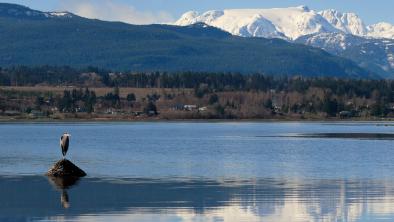Raven coal mine's rejected enviro assessment plan riddled with omissions

The Tyee
By Torrance Coste
June 20, 2013
Last month, those following the development of the Raven coal mine in the Comox Valley expected the proposal to enter its final 180-day review. Instead, the BC Environmental Assessment Office (EAO) rejected the application in its current form after a six-week screening.
The application that was submitted by the proponent, Vancouver-based Compliance Energy, is the result of years of presumed research and consultation and has been the company's primary focus. The application was based on a series of clearly outlined requirements, issued by the EAO to the proponent last summer. But despite all this preparation, the EAO's rejection notice included a big list of required information that the company just didn't bother to include.
Compliance had clear criteria to base its application on, and it utterly failed to meet these criteria. There aren't just one or two instances of missing information or technical discrepancies -- there are hundreds.
Some of the omissions include incomplete planning for dealing with long-term damage, missing information on drinking water impacts, and insufficient consultation with First Nations who would be impacted by the mine.
Other mistakes are downright sloppy: un-defined acronyms, missing tables, an incomplete executive summary, and large inconsistencies between different sections of the application, to name a few.
An example of this carelessness can be found in the description of the project's physical footprint at the mine site. The application's preface states that the footprint would be 78 hectares, but then in another section, it is listed at 200 hectares. This is a difference of 182 hectares -- the equivalent of around 260 regulation FIFA soccer fields.
In a section on mitigating the mine's effects, the application simply states that "the appropriate mitigation measures will be implemented," without providing any specific measures at all.
A section on First Nations information features an out-of-date contact list for one nation, and ethnographic information for another gathered through a basic online search rather than proper engagement. There is also no analysis of First Nations cultural landscapes near the mine site or transport route.
All of these things were specifically requested by the EAO. This is an application for a massive and contentious development, yet you will find far more attention to detail, accuracy, and basic care in a grade school book report.
Stephen Ellis, Compliance's Vice President of Operations, has publicly dismissed the EAO rejection as expected and part of the process. When asked in a CBC interview what he thought of the 114-page catalogue of mistakes issued by the EAO, Ellis said given the application's length, "I don't think it's too bad."
This casual attitude is especially concerning from Ellis, who was production manager at New Zealand's Pike River coal mine when it was hit by one of the worst mining disasters in that country's history in November 2010.
Compliance will pour in more time and money, and then re-submit its proposal. But it won't change the fact that this project is absolutely unsustainable. What's more, its environmental impacts could threaten more sustainable activities like tourism and the world-famous Baynes Sound Shellfish industry.
The Raven Coal mine represents a step in the opposite direction we need to be headed on the Island -- a regression to an activity best left in the past. Vancouver Island is a place with so much potential to lead in the development of a more sustainable economy, but this mine would squander that potential.
The ball is back in Compliance's court now, but we will continue to send them a clear message: it's 2013, not 1913, and Vancouver Island doesn't want a new coal mine.

